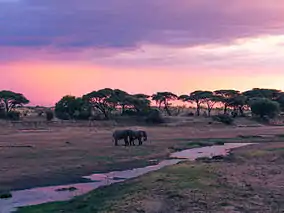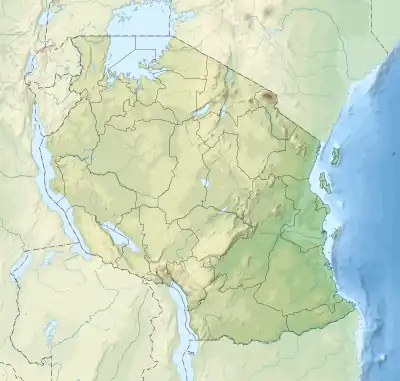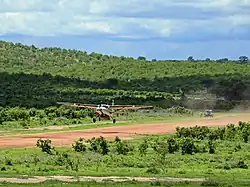Ruaha National Park
Ruaha National Park is a national park in Tanzania. The addition of the Usangu Game Reserve and other important wetlands to the park in 2008 increased its size to about 20,226 km2 (7,809 sq mi).
| Ruaha National Park | |
|---|---|
 | |
 | |
| Location | Tanzania |
| Nearest city | Iringa |
| Coordinates | 7°30′S 35°00′E |
| Area | 20,226 km2 (7,809 sq mi) |
| Established | 1964 |
| Visitors | 21,267 (in 2012[1]) |
| Governing body | Tanzania National Parks Authority |
The park is about 130 kilometres (81 mi) west of Iringa. The park is a part of the 45,000 square kilometres (17,000 sq mi) Rungwa-Kizigo-Muhesi ecosystem,[2] which includes the Rungwa Game Reserve, the Kizigo and Muhesi Game Reserves, and the Mbomipa Wildlife Management Area.[3]
The name of the park is derived from the Great Ruaha River, which flows along its southeastern margin and is the focus for game-viewing. The park can be reached by car on a dirt road from Iringa and there are two airstrips – Msembe airstrip at Msembe (park headquarters), and Jongomeru Airstrip, near the Jongomeru Ranger Post.[2]
History and wildlife

Germany gazetted the Saba Game Reserve in 1910. British colonial authorities changed the name to the Rungwa Game Reserve in 1946.[2] In 1964, the southern portion of the reserve was excised and elevated to full park status.[2]
More than 571 species of birds have been identified in the park. Among the resident species are hornbills.[2] Many migratory birds visit the park.[2]
Other noted animals found in this park are East African cheetah,[4] East African lion, African leopard, wild dog, spotted hyena, giraffe, hippopotamus, African buffalo, and sable antelope.[2][5]
Since 2005, the protected area is considered a Lion Conservation Unit.[6]
Issues
- The park was formerly known for its large elephant population.[2] It had numbered 34,000 in the Ruaha-Rungwa ecosystem in 2009,[7] before declining to only 15,836, plus or minus 4,759, in 2015.[8]
- In February 2018, the carcasses of 6 lions and 74 vultures were found. They appear to have been poisoned.[9][10]
References
- "Tanzania National parks Corporate Information". Tanzania Parks. TANAPA. Archived from the original on 17 September 2008. Retrieved 22 December 2015.
- "Ruaha National Park". Tanzania National Parks. 2012. Archived from the original on 2012-09-29. Retrieved 23 November 2014.
- Mbomipa Wildlife Management Area. Twma.co.tz. Retrieved on 14 September 2016.
- PH (2018-02-23). "Tanzania: 5 Reasons To Visit Ruaha National Park". HowAfrica.com. Retrieved 2018-02-24.
- "Research". Ruaha Carnivore Project. Retrieved 15 March 2017.
- IUCN Cat Specialist Group (2006). Conservation Strategy for the Lion Panthera leo in Eastern and Southern Africa. Pretoria, South Africa: IUCN.
- Karl Mathiesen (2 June 2015). "Tanzania elephant population declined by 60% in five years, census reveals". The Guardian. Retrieved 15 March 2017.
- Adelhelm Meru, Permanent Secretary, Tanzania Ministry of Natural Resources and Tourism (2 November 2015). "Press Release: Ruaha-Rungwa Ecosystem Elephant Census Results, 2015". Retrieved 15 March 2015 – via Tanzania Wildlife Research Institute.
{{cite web}}: CS1 maint: multiple names: authors list (link) - Kamoga, J. (2018). "East African lions dying of poisoning". The Observer. Retrieved 2018-02-24.
- Winter, S. (2018-02-16). "Lion MASSACRE as six big cats die after eating 'poison'". Daily Express. Retrieved 2018-02-24.